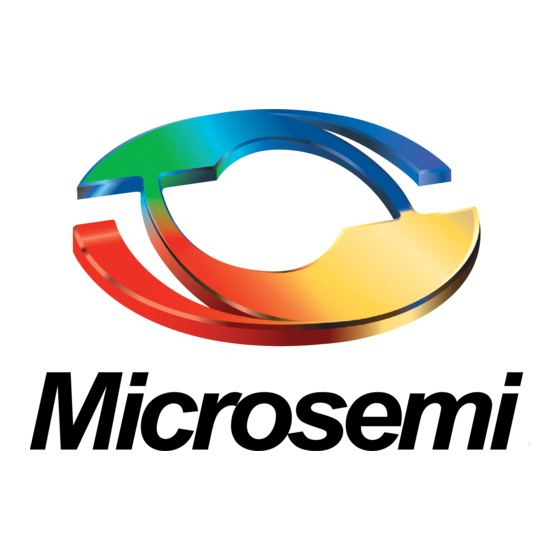

Microsemi SmartFusion2 MSS Manual
Can configuration
Hide thumbs
Also See for SmartFusion2 MSS:
- User manual (829 pages) ,
- Demo manual (40 pages) ,
- Configuration manual (23 pages)
Table of Contents
Advertisement
Quick Links
Advertisement
Table of Contents

Summary of Contents for Microsemi SmartFusion2 MSS
- Page 1 SmartFusion2 MSS CAN Configuration...
-
Page 2: Table Of Contents
SmartFusion2 MSS CAN Configuration Table of Contents Introduction ..............3 1 Configuration Options. -
Page 3: Introduction
The functional behavior of the CAN instance must be defined at the application level using the SmartFusion2 MSS CAN Driver provided by Microsemi. In this document, we describe how you can configure the MSS CAN instance and define how the peripheral signals are connected. -
Page 4: Configuration Options
1 – Configuration Options There are no hardware configuration options for the CAN peripheral. Note: If the CAN instance is enabled, M3_CLK must be a multiple of 8MHz. This restriction will be enforced in the MSS CCC Configurator. -
Page 5: Peripheral Signals Assignment Table
2 – Peripheral Signals Assignment Table The SmartFusion2 architecture provides a very flexible schema for connecting peripherals signals to either MSIOs or the FPGA fabric. Use the signal assignment configuration table to define what your peripheral is connected to in your application. This assignment table has the following columns (Figure 2-1): MSIO - Identifies the peripheral signal name configured in a given row. -
Page 6: Connectivity Preview
3 – Connectivity Preview The Connectivity Preview panel in the MSS CAN Configurator dialog shows a graphical view of the current connections for the highlighted signal row (Figure 3-1). Figure 3-1 • CAN Connectivity Preview... -
Page 7: Resource Conflicts
4 – Resource Conflicts Because MSS peripherals (MMUART, I2C, SPI, CAN, GPIO, USB, Ethernet MAC) share MSIO and FPGA fabric access resources, the configuration of any of these peripherals may result in a resource conflict when you configure an instance of the current peripheral. Peripheral configurators provide clear indicators when such a conflict arises. -
Page 8: Error Example
Error Example The USB peripheral is used and uses the device PAD bounded to package pin V24. Configuring the CAN peripheral such that the RXBUS port is connected to an MSIO results in an error. Figure 4-1 shows the error icon displayed in the Connectivity Assignment table for the RXBUS port. Figure 4-1 •... -
Page 9: Warning Example
Warning Example The GPIO peripheral is used and uses the device PAD bounded to package pin V24 (GPIO_3). Configuring the CAN peripheral such that the RXBUS port is connected to an MSIO results in a warning. Figure 4-3 shows the warning icon displayed in the Connectivity Assignment table for the RXBUS port. Figure 4-3 •... -
Page 10: Information Example
Information Example The USB peripheral is used and uses the device PAD bounded to package pin V24. Configuring the CAN peripheral such that the RXBUS port is connected to the FPGA fabric does not result in a conflict. However, to indicate that he PAD associated with the RXBUS port (but not used in this case), the Information icon is displayed in the Preview panel (Figure 4-5). -
Page 11: Port Description
5 – Port Description Table 5-1 • Port Description Port Name Port Group Direction Description CAN_PADS Local receive signal. CAN_FABRIC CAN_PADS CAN bus transmit signal. CAN_FABRIC TX_EN_N CAN_PADS External driver control signal. / This is used to disable an external CAN transceiver. / TX_EN_N is asserted when the CAN_FABRIC CAN controller is stopped or if the CAN state is bus-off. -
Page 12: A Product Support
Microsemi SoC Products Group staffs its Customer Technical Support Center with highly skilled engineers who can help answer your hardware, software, and design questions about Microsemi SoC Products. The Customer Technical Support Center spends a great deal of time creating application notes, answers to common design cycle questions, documentation of known issues, and various FAQs. -
Page 13: Itar Technical Support
My Cases Microsemi SoC Products Group customers may submit and track technical cases online by going to Cases. Outside the U.S. Customers needing assistance outside the US time zones can either contact technical support via email (soc_tech@microsemi.com) or contact a local sales office.








Need help?
Do you have a question about the SmartFusion2 MSS and is the answer not in the manual?
Questions and answers